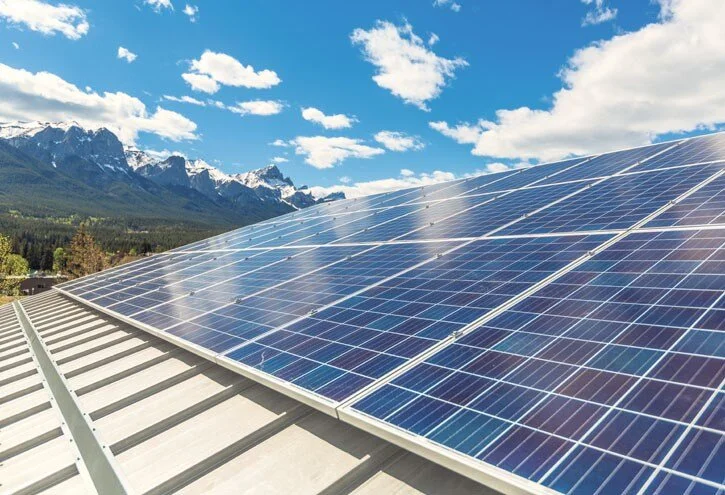Biosphere Institute Explores Community Solar Project
Rocky Mountain Outlook | June 20, 2019 | By Alana MacLeod
CANMORE – A new community project aiming to reduce Canmore’s environmental footprint is searching for rooftops for rent to potentially house solar panels.
The Town of Canmore Civic Centre roof has 192 solar panels on it, delivering 68,000 kilowatt hours of electricity to the facility.
CANMORE – A new community project aiming to reduce Canmore’s environmental footprint is searching for rooftops for rent to potentially house solar panels.
The Biosphere Institute of the Bow Valley in partnership with KCP Energy is in the midst of a feasibility study to see how a community generation project based around solar energy would function in the town of Canmore.
The concept is essentially to create community owned renewable energy that the community members who participate in the project could then share the profits.
Jodi Conuel, the program associate at the Biosphere Institute, said the project is currently in phase one and mostly revolves around community engagement.
“The reason for choosing solar is that it doesn’t impact on the town’s footprint, development footprint, so the big idea is to look at renting out rooftop space from residents or business owners and using that space to install solar panels,” she said. “The feasibility study part one is to look at community engagement, talking to people to see if they’re interested in renting out their rooftop, is this a feasible idea.
“If people are interested – how many solar panels can we fit on a roof, how would we connect to the grid, and which properties would be best aligned with solar? To do this we’re going to be working with KCP energy who are going to be undertaking solar assessments on buildings within town who have indicated an interest.”
According to the Biosphere, community owned projects like this allow local citizens to not only generate electricity, but be part of how it is controlled and profit from its success.
Part of phase one of the project incorporates pioneer consulting done by the University of Calgary. Essentially this consulting ranks the neighbourhoods in Canmore from one to 36 in terms of what areas are more viable for solar panels. The ranking is based on how much sunlight an area, or building, receives throughout the course of the day as well, as the design of the rooftop itself.
“The top place in Canmore is actually Elk Run for solar potential looking at the type of buildings and the way the roof align as well as how much sunlight it gets,” Conuel said.
“We’ve basically taken the top ten list and we’re targeting those neighbourhoods, however we’re doing this for efficiency sake. If anybody is interested in renting out their rooftops – no matter where they are in Canmore – they’re more than welcome to put their name, and rooftop, forward and we will do a solar assessment on their property.”
Phase two of the project looks at community based financing and how the project would move forward. Conuel said they’re currently looking at an opportunity development co-operative model.
“The reason we’re looking at an opportunity development cooperative model is it’s usually the most popular and effective option for financing a community renewable project,” she said.
“This concept also underlines a business model. It’s a way of structuring an enterprise, so it’s owned by the people who use it and benefit from the service it offers.”
The solar panel concept isn’t a new one. In fact, one Canmore native, Joey O’Brien, added 40 solar panels to his rooftop roughly six years ago.
“Our solar assembly is 40, 250-watt panels, which when you add it up is ten kilowatts. So what does that mean – it’s the first question people ask,” he said.
“From a physical point of view, it covers most of the south facing roof we have … What it allows you to do is to use the grid as a battery and so when I produce more energy than I consume, it pushes energy into the grid. When we consume more than we produce, we draw from the grid.”
O’Brien said in places like Britain, the energy stored in the grid allowed for that country to go two weeks without a single coal plant being turned on.
“They’re running 100 per cent on renewable energy from the last two weeks. So it’s very doable,” he said.
For O’Brien, who also runs a sustainability company called Sustain Driven, the Biosphere Institutes concept is a no brainer.
“If you look at the penetration model in the United States, it’s exactly the same as the model that the Biosphere is pushing forward,” he said.
“If I look at May or June’s power bills for me … I produce so much power I eliminate all extra [power associated] fees … Half the year I eliminate my power bill almost totally.”
The project is still in phase one, but if you’re interested in renting out your rooftop, you can find out more information at www.biosphereinstitute.org.

